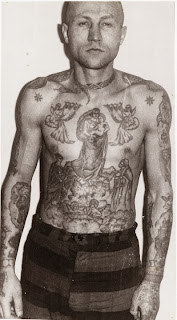A thief in law (Russian: vor v zakone) in the Soviet Union, the post-Soviet states and respective diasporas abroad is a specifically granted formal status of a professional criminal who enjoys elite position within the organized crime environment and employs informal authority over its lower-status members. Each new Vor is vetted (literally "crowned", with respective rituals and tattoos) by consensus of several Vors. Vor culture is inseparable with prison organized crime: only repeatedly jailed convicts are eligible for a high Vor status. Thieves in law are drawn from many nationalities from a number of post-Soviet states. According to the estimates of the Russian Ministry of Internal Affairs, there were about 500 "thiefs-in-law", with the majority being of Caucasus ethnicities.(source: Wikipedia).
The Vor v Zakone are also known for their impressive tattoos. Tattoos are often done as a rite of passage in the criminal world - some of the Vor v Zakone members are tattooed before they are even sentenced to prison. It is hard to decode these tattoos because most of the tattoos have multiple hidden meanings. Some of the most common imagery is religious: the Madonna and Child, Russian churches, crosses, etc. However, these tattoos have absolutely nothing to do with religious beliefs; their real meanings are rooted in prison and criminal traditions.
For example, Madonna and baby Jesus is one of the most popular tattoos worn by criminals, and usually this tattoo symbolise loyalty to a criminal clan (the bearer of the tattoo is "clean before his friends" in that he will never betray them to authorities); it can also mean that the wearer believes the Mother of God will ward off evil; as well as meaning that the wearer has been behind bars from an early age.


No comments:
Post a Comment